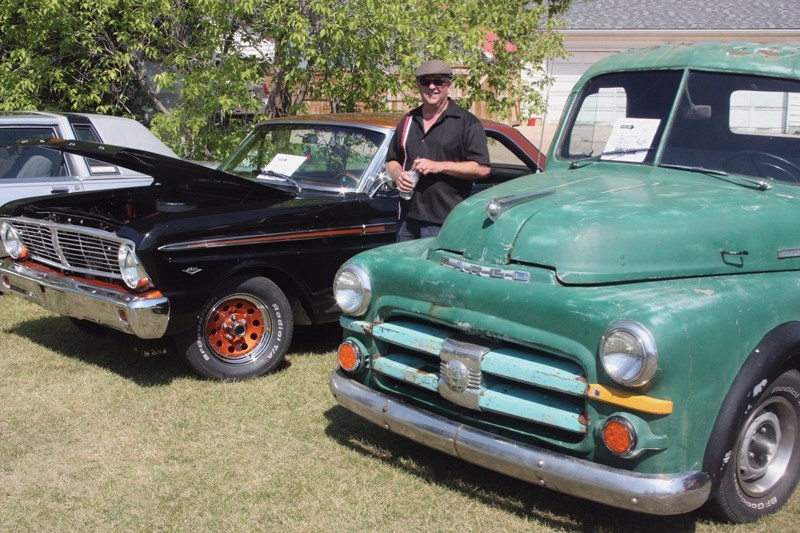”Now you understand why we do it,” Jim Smith said after we got back from a ride in his 1951 Fargo, which he kindly let me drive last week.
That would be an understatement. Not only do I have a pretty good idea of why someone would want to fix up and drive an old car, I’ll now be hard-pressed to convince my family we need to find space in the carport for an antique vehicle.
The reason they do it is simple: old cars are just incredibly fun to drive.
Smith is a member of the Westlock Wheels of Class car club, and he had two vehicles in the Show & Shine at Lindahl Park in Westlock last Sunday: a restored 1965 Ford Falcon and an original 1951 Fargo.
I asked around the car club last week to see who might have an interesting vehicle I could talk to them about, and Smith’s name immediately came up.
His Fargo might be especially interesting to those in the Westlock area, since it came from Herb Seatter in the Dapp area.
“My father-in-law bought it and gave it to me and the boys,” Smith said.
Although the truck was in running condition with a three-speed engine, he put in a new engine that came out of a 1989 Dodge with about 68,000 kilometres on it.
With the new engine put in place, as well as the addition of a few modern amenities like power steering and power brakes, he’s now comfortable enough with it to drive it to B.C. for the Radium car show. He took it last year and plans to go again this year.
Smith has about 25 years of experience tinkering with old cars, and has had about a dozen classic or antique cars come and go in that time. It’s a long-term hobby and no small time commitment — in the winter he might spend 15 or more hours per week in his garage.
“It’s a labour of love,” he said. “It just kind of grows on you.”
And sometimes, the love of the hobby is tested. He bought the 1965 Falcon already painted, and thought it wouldn’t need too much work.
After he got it, though, he spent a long time agonizing about an electrical short he couldn’t track down, until one day he discovered it was in the steering column, which hadn’t been put together properly.
“It took me a week of looking then just one night to fix it,” he laughed.
But the problem-solving aspect of it, first figuring out what the problem is then figuring out how to fix it, is all part of the fun.
Smith said when the going gets too tough for one of the 15-20 members of the club, they take their vehicles and their problems to club member Dave Ristoff, who’s something of a local expert — although he might not agree.
I was able to pull Ristoff away from his responsibilities at the show long enough to pick his brain a bit about why he works on old cars, and he was almost at a loss to explain it.
“It’s just for something to do,” he said. “I like seeing them so they don’t go to the scrap yard and get crushed.”
In the 30 years he’s been working on old cars, he’s had perhaps as many as two dozen come and go, but there isn’t one that sticks out more than others — each one has something to recommend it.
That said, he’s not a purist for the old cars, and likes a lot of what he sees coming out these days.
“There’s some nice technology with fuel injection and other feature, safety features for sure,” he said. “If you take new power trains and put them in old cars, that’s probably the best.”
The stereotype of the amateur car mechanic is someone who does it for nostalgia, or perhaps to be able to have the car they always dreamed about when they were kids, but that stereotype is not borne out by those showing off their rides last Sunday.
In particular, a young group of recent R.F. Staples graduates were eager to talk a bit about the 1955 Dodge Regent Special Coupe Deluxe they’ve spent the last three years working on, both during class time and as part of an after-school club.
Damon Sparling said the big appeal for him is being able to push the limits of what he’s able to do and pick up some new knowledge.
“It’s different than working on modern cars, because those are just repairing and it’s all the same,” he said. “This one is custom, so you’re making your own parts and creating your own ideas. It feels pretty good to be involved in making our own vehicle.”
It’s been a slow and steady work in progress for several years, and the boys have developed a real attachment to it — so much so they’re spending much of their summer trying to get as much done as possible.
“We don’t want to pass it on, we want to keep working on it,” Sparling said.
Their passion for their work is apparent, but if they plan to get anything finalized they would do well to take a piece of advice from Smith, with his decades of experience.
“It’s never finished. There’s always something you’re fixing or changing.”



